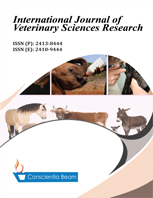Description of Immature Stages of the Brown Dog Tick Rhipicephalus Sanguineus (Acari: Ixodidae) Using Scanning Electron Microscopy
DOI:
https://doi.org/10.18488/journal.110/2015.1.1/110.1.12.30Abstract
The brown dog tick Rhipicephalus sanguineus is a three-host tick that feeds primarily on dogs and occasionally on other hosts, including humans. Therefore, this study aimed to describe in details the immature stages (larva and nymph) of R. sanguineus using scanning electron microscope (SEM) and morphometeric analyses. The measurements of nymph and larva structures are relatively close to those of Hyalomma excavatum. The number and distribution of setae on either the dorsal or ventral surfaces of nymph differ from those of other ixodid ticks. Eyes have an elongated shape in nymph and larva. The position of sternal setae in nymph resembles the position of these setae in H. dromedarii. The shape and position of spurs on coxae in nymph and larva are considered the unique characters that can differentiate this species from other three species of R. sanguineus group (R. camicasi, R. turanicus and R. sulcatus). Palpi in nymph and larva are tending to each other forming triangular shape. The apices of palpi in nymph and larva are tapering. Basis capitulum has hexagonal shape dorsally in nymph and larva. Basis capitulum of nymph has a pair of spur-like ventrally. Further studies are needed in details on the immature stages of other tick species of R. sanguineus group such as R. camicasi, R. turanicus and R. sulcatus using advanced techniques such as SEM or molecular biology. These techniques may provide additional characteristics which may facilitate the identification of the immature stages of R. sanguineus group.

